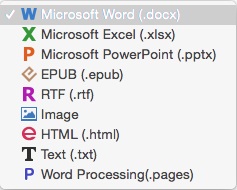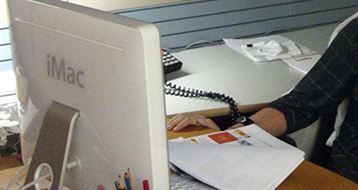OCR, short for Optical Character Recognition, is the method of turning a file of text that is not editable, for instance if it is a scan of a document page or similar, into a fully editable text document that can by adjusted, searched and otherwise manipulated as a normal text file. This can be extremely useful in many situations as you can imagine, and one of the ways people can carry out this is with open source OCR. This has the benefit of being free, and easily available on multiple platforms, but is it the ideal solution if you need to turn pages of a scanned book into something you can search and edit?
Recommendation: The Best PDF OCR Tool - iSkysoft PDF Editor 6 Professional for Mac
iSkysoft PDF Editor 6 Professional for Mac (or iSkysoft PDF Editor 6 Professional for Windows) enables the advanced OCR feature helping you to edit and convert image-based and scanned PDF files. And it supports multiple OCR languages to make it more convenient to handle PDF files.
Why Choose This PDF OCR Tool:
- Advanced OCR feature with multiple languages.
- Easily edit and mark up PDF files.
- Convert PDF to other formats.
- Create PDF and PDF forms with ease.
- Secure PDF with password, watermark and signature.
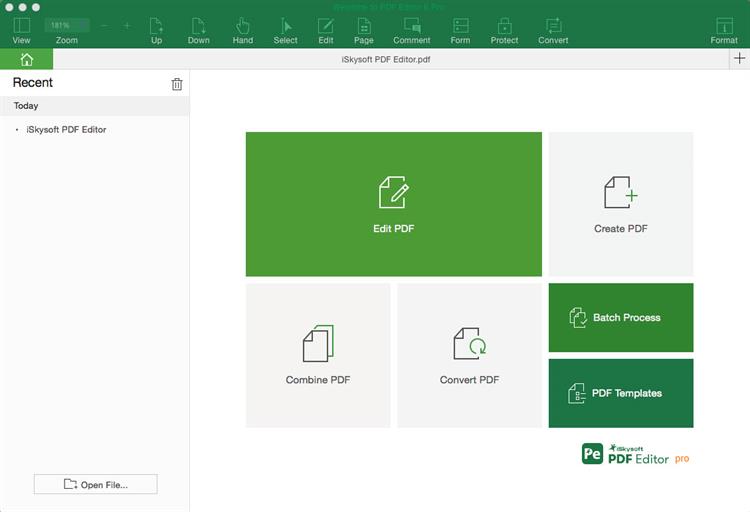
Part 1. Recommended Open Source PDF OCR Software
#1. Tesseract
Tesseract is a wonderful open source piece of software that is currently maintained by Google. It can be used on a variety of platforms including Linux, Windows and OS X. It includes support for several languages, and with the ability to download even more via extensions, it brings a wealth of options that will cover almost any project. However, it is somewhat overcomplicated in terms of use and to get the very best from it requires some understanding of the underlying code. In use though, it produces accurate results and with that multi-platform support can prove useful in a wide variety of situations. A rather steep curve to learn the software, but it is very capable afterward.
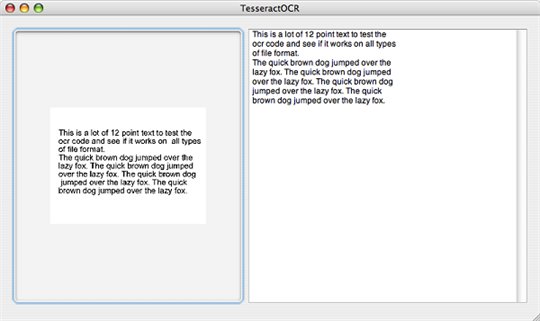
#2. GOCR
This is another open source package that is designed to run on Linux, Windows and OS/2 platforms, providing a wealth of choice for almost any situation. As with other open source examples of OCR software the process is accurate and the package expandable, however it suffers from similar issues with usability. This varies somewhat depending on the platform being used, with some having a more user friendly front end than others, however it is still a capable tool once in use.
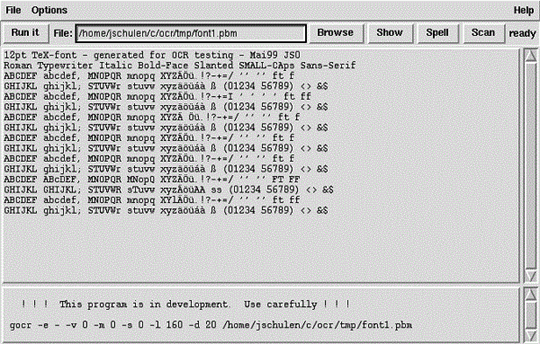
#3. Cuneiform
Originally a commercial OCR solution, Cuneiform was converted to open source by its developer when further development of the project ceased. Because of this it is not the most up to date solution available, but is effective nonetheless. This is a multi-language piece of software that still works well today, and because of its commercial roots does manage to avoid some of the pitfalls of other open source solutions, such as unintuitive user interfaces and so on, and is the easiest of the three to use. With multiple output formats and a lot of customization possible it is a good piece of software, if lagging behind technically today in comparison to some.
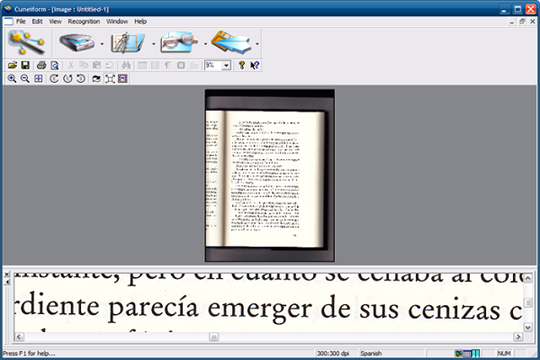
Comparison of the above OCR Resources
|
Features |
Tesseract |
GOCR |
Cuneiform |
|---|---|---|---|
|
Compatible Operating System |
OS X, Windows, Linux | Windows, Linux, OS/2 | Windows |
|
Languages |
12 (plus expansions) | 2 | 20 |
|
File Conversion |
Forum/Mailing List | Mailing List | No |
|
Support |
No | No | No |
Verdict:
There is no doubt that these open source packages offer a way to perform OCR on your documents, however they do all lack a little somewhere, whether it be the ease of use or being somewhat outdated and not taking full advantage of today's multicore processors for speed. With that in mind many people turn to more comprehensive commercial packages to meet their OCR needs, and with comprehensive support, ease of use and reliability it is no surprise really. Open source products do have their place, but for many relying on the tools and needing something that is a little easier to run, the costs are very often well worth it in the long run.
Part 2. Learn How to Perform OCR on Image-Based PDF File
Method 1. Perform OCR with iSkysoft PDF Editor 6 Professional for Mac
The advanced OCR function in iSkysoft PDF Editor 6 Professional for Mac (or iSkysoft PDF Editor 6 Professional for Windows) will help to OCR your PDF files easily. Please follow the steps below.
Step 1. Launch Program
After you launch the program, click the "Open File" to import the scanned PDF file to the softwarte. You will get a notification showing that the file is a scanned PDF.
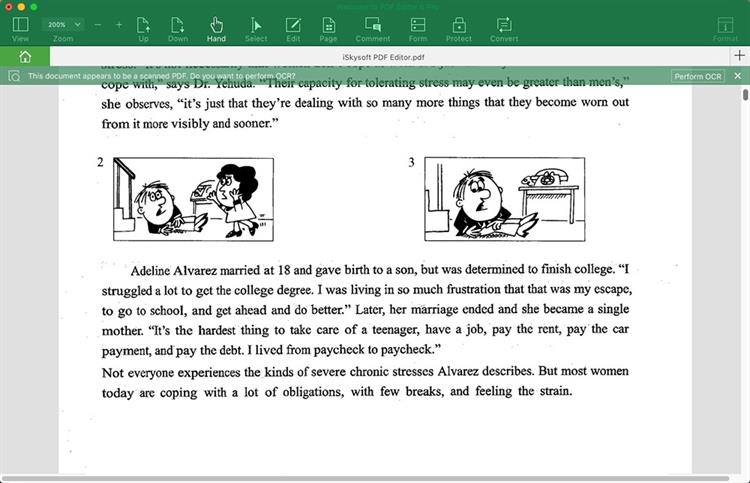
Step 2. Perform OCR
Then you can click the "OCR" button under the "Edit" tap. You can open the OCR panel on the right side of the program interface. Now you can customize the page range and the OCR language. And then click on the "Perform OCR" button to OCR the scanned PDF.
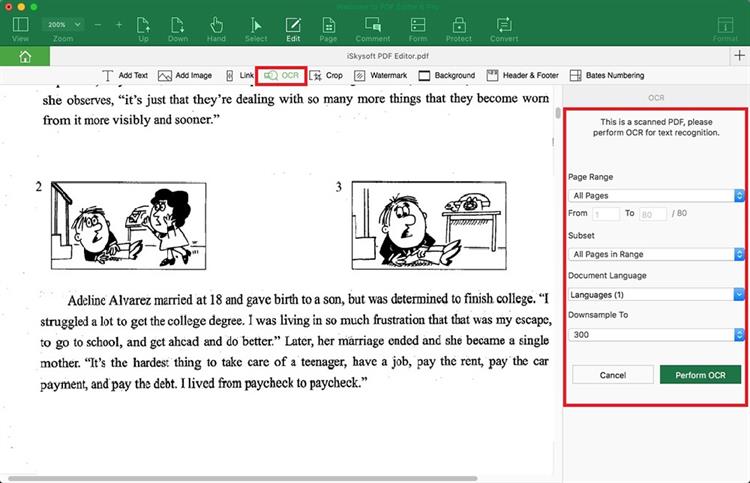
Method 2. Perform OCR with PDF Converter Pro for Mac
The best option available for PDF OCR is iSkysoft PDF Converter Pro for Mac, which is a very comprehensive software package that not only features easy to use OCR features but is also a PDF conversion package in its own right, providing a wealth of tools for manipulating PDF files and producing other formats from them at will.
Starting with extremely easy to understand interface, PDF Converter Pro for Mac can OCR your files in 17 different languages, meeting the needs of most projects right out of the box. In addition, it can output in a wide variety of formats including Word, Excel, Epub (eBook format), rich text and of course plain text files. The OCR engine is extremely accurate and the software includes a batch processing menu that allows up to 200 files to be OCR'd with the press of one button. That is very useful for OCR of individual scanned pages of a book and saves a lot of time.
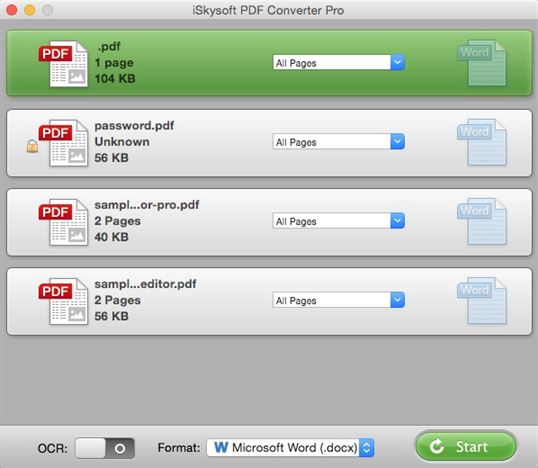
Step 1. Load PDFs to the Program
Double click the application icon to launch the program and directly drag and drop the PDF file you want to convert to the main interface of the program. Alternatively, you can go to the File menu and select the Add PDF Files option to import the file to the program. This converter supports batch conversion, so you are able to add multiple files and convert them at a time.
And then go to the PDF Converter Pro tab and select the Preferences option, you will get a pop-up window. Now click the OCR tab in the window and select the OCR recognition language you want.
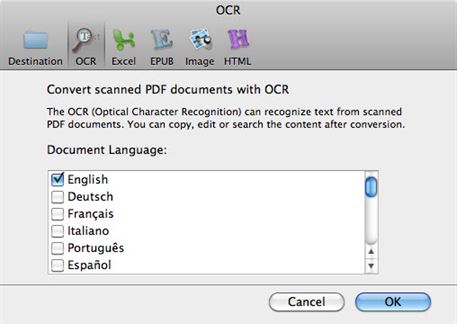
Step 2. Convert Scanned PDFs to Text
When you have customized the language, check the Convert Scanned PDF Documents with OCR option at the bottom toolbar to enable the OCR function. Then click on the Gear icon to open the window for choosing output format. Just select Plain Text as the output format. Last, click the Convert button at the bottom right corner to start the conversion.
This smart PDF tool can decrypt the password protected PDF files automatically. So, if the PDF files are protected from printing or copying, you can directly import them to the converter and select settings to start the conversion. But if your PDF files are Open Password protected, when you import them to the converter, you have to input the correct password to unlock the files.
